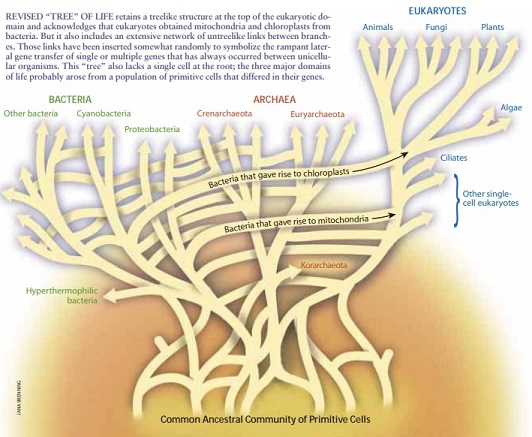Organisms
Definitions
The word "Organism" comes from the word "Organ" and the suffix "-ism". In biologic terms, "Organ" refers to a grouping of tissues into a distinct structure, as a heart or kidney in animals or a leaf or stamen in plants, that performs a specialized task, whereas "-ism" is a suffix appearing in loanwords from Greek, where it was used to form action nouns from verbs. The term "Organism" itself has many different ways of being defined but is generally referred to as a form of life composed of mutually interdependent parts that maintain various vital processes.
History

Organisms range from basic, singular cells, to complex eukaryotes such as plants and animals. Around the time of Aristotle, scientists would figure out the genealogy of organisms simply by comparing their physical features to one another. This continued right up until the 1960's, at which time scientists started to create a universal phylogeny tree for every type of known organism. The tree began when two researchers, Emile Zuckerkandl and Linus Pauling of the California Institute of Technology, began basing ancestral organisms on genetic differences rather than physiology, making the relation of organisms much more precise. It was then that organisms were found to be divided up into two main groups, eukaryotes and prokaryotes. During the late 1970's, a scientist by the name of Carl R. Woese discovered that by using the SSU rRNA, small subunit ribosomal RNA, he could find the moment where organisms start to diverge and become separate entities. It was shortly after this discovery that Woese determined that not all prokaryotes could genetically be defined as bacteria, and so a third main group needed to be included, the archaea. These three main groups are still accepted today as the correct set of ancestral organisms that make up every other organism on the planet. However, it has recently been discovered that the original three groups somehow laterally share their genes, making all organisms a conglomerate of prokaryotes, archaea, and eukaryotes. It is currently believed that the current phylogeny "tree" is some sort of interlacing web without any one definite source of original life.
References
1."organism". Dictionary.com Unabridged. Random House, Inc. 18 Feb. 2018. <Dictionary.com http://www.dictionary.com/browse/organism>.
2. Doolittle, W. F. (2000), "Uprooting the tree of life" (PDF), Scientific American, 282 (6): 90–95, Bibcode:2000SciAm.282b..90D, doi:10.1038/scientificamerican0200-90, PMID 10710791, archived from the original (PDF) on 2011-01-31.